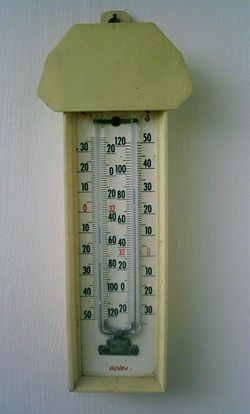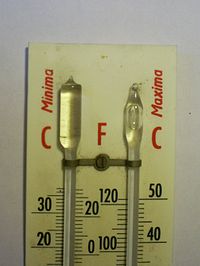- Six's thermometer
-
A maximum minimum thermometer. The scales are Fahrenheit on the inside of the U and Celsius on the outside. The current temperature is 23 degrees Celsius, the maximum recorded is 25, and the minimum is 15, both read from the base of the small markers in each arm of the U tube. The bulbs are hidden by a plastic housing.

Six's thermometer is a thermometer which can measure the maximum and minimum temperatures reached over a period of time, usually during a day. It is commonly used wherever a simple way is needed to measure the extremes of temperature at a location, for instance in meteorology and horticulture.
It is also commonly known as a maximum minimum thermometer, of which it is the earliest practical design and the most common type used.
It is an example of a registering thermometer, that is a thermometer that keeps a record of where the temperature has been in the past.
It gives three readings: the current temperature, the highest temperature reached since it was last reset, and the lowest temperature reached since it was last reset.
It was invented by Englishman James Six in 1782, and named after him. The same basic design remains in use today.
Contents
Description
This describes the traditional construction. Modern designs may substitute materials for less toxic ones but operate in the same way.
It consists of a U-shaped glass tube with two separate temperature scales set along each arm of the U. One of these is for recording the maximum temperature encountered and the other for the minimum temperature. The arms of the U-shaped tube terminate in sealed glass bulbs. The bulb at the top of the minimum reading scale arm is full of alcohol, the other contains a vacuum (or low pressure alcohol vapour). [1]
Detail of the thermometer bulbs of the maximum minimum thermometer shown above. The left-hand (minimum arm) bulb is full of alcohol. This bulb measures the temperature by the expansion and contraction of the liquid. The right-hand (maximum arm) bulb contains alcohol and a bubble of low-pressure gas or alcohol vapour. This bulb accommodates the expansion in the other bulb and allows the train of alcohol and mercury to move in the U-shaped tube as the temperature changes.
In the bend of the U is a section of mercury, a metal which is liquid at normal temperatures. This is pushed around the tube by the thermal expansion and contraction of the alcohol in the first bulb as it responds to the external temperature. The near vacuum in the other bulb allows free movement of the alcohol and mercury. It is the alcohol which measures the temperature; the mercury indicates the temperature reading on both scales. This is unlike a normal mercury thermometer, in which the expansion and contraction of mercury itself indicates temperature.[1]
The thermometer shows a reading at the top of the mercury section on both the maximum and minimum scales; this shows the current temperature and should be the same on both scales. If the two reading are not the same, then the instrument scales are not correctly positioned or the instrument is damaged.[1]
The maximum and minimum readings are recorded by two small steel markers which are sprung into the capillary tube so that they cannot easily slide unless a small force is applied to them.
Before a maximum or minimum reading can be taken, both markers must be returned to the top of the mercury, usually by hand using a small magnet to slide them along the tube. Any change in temperature after that time will push one of the markers along with it.
If the temperature is rising, then the maximum scale marker will be pushed. If it falls after the reset, then the moving mercury will push the minimum scale marker. Often both things happen one after another as the temperature changes, say through a twenty-four-hour period (see diurnal temperature variation). The markers thus record the furthest point reached by the mercury in each arm of the tube. They record the extremes of temperature experienced by the device since it was last reset. The thermometer is usually reset every day, but if left for longer the readings would show the highest and lowest temperatures encountered since the instrument was last reset.
To take a reading, the positions of the ends of the markers nearest to the mercury are examined. Their positions on the maximum and minimum scales show the highest and lowest temperatures encountered over the period of measurement.[3]
Design variations
In a variation of design, some models have unsprung markers held in place by a magnetic plate located behind the card showing the scales and close enough to the U-shaped tube to immobilize the markers unless they are pushed by the thermal expansion of the device. When a central button is pressed, the plate is pushed away from the U-shaped tube, freeing the markers which then sink under gravity until they rest again on the surface of the mercury.
Another design has the U orientated horizontally and the markers completely free and unsprung. In this model, the reset is carried out by turning the U to the vertical so the markers sink to rest on the mercury and the U is then returned to the horizontal.
Maintenance
The Six's thermometer is notoriously known for separations in the mercury column, in particular after shipment, though accidental knocks have been known causes as well. Separations can usually be corrected by swinging the thermometer like a large old school fever thermometer. The centrifugal force will then force the mercury together again, hence the separation is corrected. Should the markers be partly buried in the mercury, they can either be pulled up again with the magnet or put to a temperature change that leaves the markers uncovered. It is however important not to use a magnet to pull up the markers in the push-button type because there is a risk of damaging the weak magnet behind the scale or magnetising the steel in the markers with equally fatal consequences – either weakening or enhancing the pulling force against the capillary tube on all or part of the scale.
Mercury Free Maximum Minimum Thermometer
The original Six's thermometer design contains mercury which has been banned for most uses in the EU [4] and some other parts of the world.
This does not mean the end of Six's thermometer: in 2006 S.Brannan & Sons Ltd, a UK company, was granted a patent for a mercury free version of Six's Maximum Minimum Thermometer: instead of mercury two immiscible liquids are used supporting an index. The thermometer operates in exactly the same way as the old mercury model.
See also
References
- ^ a b c The World of Physics By John Avison, page 180, Publisher Nelson Thornes, 1989 ISBN 0174387334. Accessed April 2011
- ^ Six's Maximum and Minimum Thermometer O Level Physics Notes, A Star Maths and Physics. 24 December 2010, Accessed April 2011
- ^ Weather for Schools, Staffordshire School Weather Data Site, Alan Rodgers & Angella Streluk, 7 March 2010, Accessed April 2011
- ^ Jones H. (July 10, 2007). "EU bans mercury in barometers, thermometers". Reuters. http://www.reuters.com/article/environmentNews/idUSL0988544920070710. Retrieved 2008-05-30.
- Two hundred years of the Six's Self Registering Thermometer Austin and McConnell, Notes and Records of the Royal Society of London * Vol. 35, No. 1, Jul., 1980 at JSTOR
- A History of the Thermometer and Its Uses in Meteorology by Amit Batra, Johns Hopkins University Press, 1966; ISBN 0-8018-7153-0
- The Construction of a Thermometer by James Six, Nimbus Publishing Ltd,1980; ISBN 0-9507036-0-5
External links
Categories:- Thermometers
Wikimedia Foundation. 2010.


